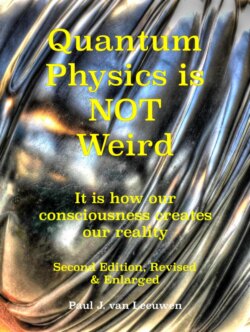Читать книгу Quantum Physics is NOT Weird - Paul J. van Leeuwen - Страница 29
На сайте Литреса книга снята с продажи.
Energy is equal to mass according to Einstein
ОглавлениеIn setting up his special theory of relativity in 1905, Einstein derived the equivalence of mass and energy: E = mc2 [17]. The meaning of this simple but astounding formula is often interpreted as the idea that mass can be converted into energy (and vice versa). But Einstein's own interpretation is that mass and energy are two sides of the same coin. That means literally that an amount of energy has also a corresponding amount of mass. A small lump of matter therefore represents an enormous amount of ‘solidified’ energy. A mass of 1 kg is equal to an energy of 9x1016J. Just compare this with the total annual energy consumption of The Netherlands: 3.1 x 1018J: an energy equivalent to about 35 kg of mass. The theory says also that the mass of an accelerated object increases with its increasing speed. Some form of energy must be transferred to the object to accelerate it. The kinetic energy, the energy that a moving object possesses by its movement, will increase and therefore, conform E = mc2, also its mass.
The increasing mass with increasing velocity is an effect that must be seriously taken into account in large particle accelerators, such as the CERN Large Hadron Collider in Geneva. Protons are accelerated to enormous speeds, very close to the speed of light – and therefore also to considerably larger masses. Because of this increase in mass, they need a correspondingly adjusted strong magnetic force field to keep them in their precise circular orbits. At particle speeds very close to that of light, the supercooled magnets used to hold the particles in their orbits must be continually and very precisely adjusted to exert the required larger centripetal forces. But in our everyday environment this effect exists too. E = mc2 means that a fully charged AA NiMh cell will have an extremely minute amount of mass increase compared with the discharged state. Something in the order of 10-10 grams.
It may even be that energy is the primary substance and that mass is only a property of it. Mass is the experience of the effort we must make to get matter moving (or to slow it down). This is known as inertial mass. Mass is also a source and receiver of gravity, which is known as heavy mass. Both may just as well be properties of primary energy. Since 2012, physicists acknowledge the existence of the Higgs field. A field from which every particle receives its inertial mass. The Higgs field is explained as a field that opposes acceleration; it gives objects their inertia. It does not oppose non-accelerated movement. Thus, a new hypothetical field is added to the set of hypothetical fields that physicists consider as being real.
With his General Theory of Relativity (introduced in 1915, confirmed in 1919, generally accepted in 1930) where he assumed inertial forces to be the same phenomenon as gravity, Einstein showed that gravity should not be seen as a force but as an effect of curved space-time, something impossible to imagine.
Anyhow, the edifice of classical physics – Newton's hard little balls model, causality and the continuity of time, fixed space and time, energy as work in stock – was teetering and started to collapse. A growing and continuously expanding need for more research was descending on the puzzled and puzzling physicists.
